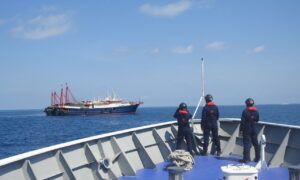Vietnam has accused China of violating its sovereignty as Beijing imposed a unilateral annual fishing ban on the South China Sea. It has again brought to international attention the long disputed waters by eight governments.
Since 1999, the Chinese communist regime has implemented seasonal fishing bans in the South China Sea every year, which have often been disputed by neighboring countries such as Vietnam. The ban will be in place from May 1 to Aug. 16 this year in order to promote sustainable fishing and improve marine ecology, Chinese authorities have said.
This covers Vietnam’s 200 nautical mile Exclusive Economic Zone (EEZ) and parts of the disputed Paracel Islands, which People’s Republic of China (PRC), Republic of China (Taiwan), and Vietnam all claim sovereignty over.
Over the years, fishermen in South China Sea nations as well as in other seas have criticized Chinese fishing boats for illegally harvesting outside China’s waters and depleting their local fish stocks and causing harm to their ocean habitats.
Illegal fishing by the Chinese Communist Party in distant oceans is plundering global fisheries resources and destroying the traditional livelihoods of many countries. The picture shows a Chinese fishing vessel operating illegally in Argentina’s exclusive economic zone on May 4, 2020. (Handout / Argentina’s Navy Press Office/AFP) A protester holds a slogan during a rally outside the Chinese Consulate in the financial district of Makati, metropolitan Manila, Philippines to mark Independence Day on June 12, 2019. The Philippine defense secretary says an anchored Filipino fishing boat has sunk in the disputed South China Sea after being hit by a suspected Chinese vessel which then abandoned the 22 Filipino crewmen. (Aaron Favila/AP)
Vietnamese Foreign Ministry spokesman Doan Khac Viet said on April 20 at a regular press conference: “The so-called fishing ban infringes upon Vietnam’s sovereignty over Hoang Sa (Paracel) archipelago, its sovereignty and jurisdiction over the seas and exclusive economic zones.”
Hoang Sa is the Vietnamese name for the Paracel Islands, which Chinese call the Xisha Islands. Vietnam has called on China to respect Vietnam’s sovereignty and “not to complicate the situation.”
An aerial view of the city of Sansha on an island in the disputed Paracel chain, which China now considers part of Hainan Province, on July 27, 2012. (STR/AFP/Getty Images)
The South China Sea is rich in resources. China asserts that it holds exclusive rights to more than 80 percent of the South China Sea—encompassing an area of 1.4 million square miles in the Pacific Ocean that holds up to 22 billion barrels of oil and 290 trillion cubic feet of natural gas.
While China claims sovereignty over the waters, citing the nine-dash line historical claims within the South China Sea, the Philippines, Brunei, Malaysia, Vietnam, and Indonesia also claim sovereignty over their exclusive economic zones in South China Sea. Some of them overlap with each other and with communist China’s nine-dash line and Republic of China (Taiwan)’s 11-dash line marked waters.
On July 12, 2016, an international tribunal ruled that the now nine-dash demarcation could not be used by Beijing to make historic claims to the South China Sea, parts of which are claimed by six governments. China rejected the ruling and has continued its sovereignty claims and operation in the South China Sea.
The PRC’s nine-dash line is based on the original 11-dash line of the South China Sea water territory of the Republic of China (1911-Present). After being defeated in World War II in 1945, Japan relinquished the territories it occupied during the war, including the Spratly and Paracel Islands in the South China Sea, where Qing Dynasty China and the ROC established garrisons and had administrative control.
The Republic of China’s original 11-dash line, including the Golf of Tonkin, from January 1947. (Secretariat of Government of Guangdong Province, Republic of China/Public domain)
After the return of sovereignty over islands, the ROC’s Executive Yuan in 1947 officially released a map titled “Position of the South China Sea Islands,” which showed an 11-dash line of water territories around a group of islands that belonged to China.
In 1948, the ROC government declared its sovereignty and the right to maritime resources over the islands and reefs within the lines. When the communist took over mainland China and established the communist state People’s Republic of China (PRC) in 1949, it recognized that line.
During Vietnam war in 1957, in a spirit of “comradeship and brotherhood,” the Chinese Communist Party’s then-leaders, Mao Zedong and Zhou Enlai, secretly signed a treaty with North Vietnam, another communist State, removing two dashes that gave Vietnam the Gulf of Tonkin and Bach Long Vi—the most strategic island in South China Sea.
Since then, PRC has been using the 9-dash line of the U-shape area in South China Sea to mark its water territory, including all islands and reefs within it, while the ROC government, which retreated to Taiwan, has retained the 11-dash line.
In recent years, the ROC government in Taiwan has reaffirmed territorial sovereignty in the South China Sea, while adopting a more cooperative approach with other countries to ensure freedom of navigation and to promote collaboration.
Meanwhile, the Chinese regime has increased its aggression in the South China Sea with other Southeast Asian countries, including Vietnam since 2019.



